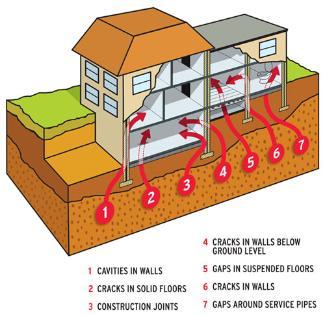Schools
What level of radon is acceptable in a school?
The responsibility of the school Principal and Board
Radon can enter a school building from the ground through small cracks in floors and through gaps around pipes or cables. Radon gas can be sucked from the ground into a school building because the indoor air pressure is usually slightly lower than outside. The reason for this is that warmer indoor air rises, resulting in slightly lower pressure indoors. Outdoors radon is diluted to very low levels.

Schools in some parts of the country are more likely to have a radon problem. These parts of the country are called High Radon Areas. You can check our interactive map to see whether your school is in a High Radon Area.
What level of radon is acceptable in a school?
Because a school is also a workplace the national Reference Level for radon in workplaces applies (300 becquerels per cubic metre (Bq/m3) measured over a 3 month period, which is specified by law in the Radiological Protection Act 1991 (Ionising Radiation) Regulations of 2019. Radon levels in all rooms should be less than 300 Bq/m3.
Read more about radon in the workplace.
The Department of Education set an advisory reference level of 200 Bq/m3 for schools in 1998. This is the same as the Reference Level for radon in homes. These two Reference Levels are applied as follows:
- Remedial work is required for any occupied classroom or office where the radon levels are greater than 200 Bq/m3.
- Following remedial work, if the radon level is between 200 Bq/m3 and 300 Bq/m3 then no further remedial work is recommended unless an additional reduction in radon can be achieved at minimal cost.
My school
Most schools have already been tested for radon. The Department of Education currently fund radon testing work and any remediation work required.
Between 1998 and 2002, the Department of Education invited all schools in the free education system to test for radon. 38,531 ground floor classrooms and offices were tested for radon in this survey. All schools with radon levels above 200 Bq/m3 were successfully remediated. For more information on the results of this survey read the full report.
How do I find the radon results for my local school?
Following the survey a report of the radon results was issued to each school. To obtain a copy of these results, please contact the school directly for these results.
When should a school be retested?
Where results were below the Reference Level, it is not necessary to retest unless significant building work has been carried out on the building. For example, work such as replacing windows, replacing the central heating system or insulating the school may result in changes to ventilation patterns with consequent changes in radon levels. Likewise, if an extension has been added to the school, the new rooms should be tested for radon.
Your school can contact the Department of Education to arrange for a radon retest.
The responsibility of the school Principal and Board
The school Principal, along with the Board of Management, has responsibility for ensuring that students and staff are not exposed to radon levels greater than the Reference Level.
For more information on radon testing in schools, please visit our radon testing page.
Contact us
FreePhone: 1800 300 600
Email: radon@epa.ie